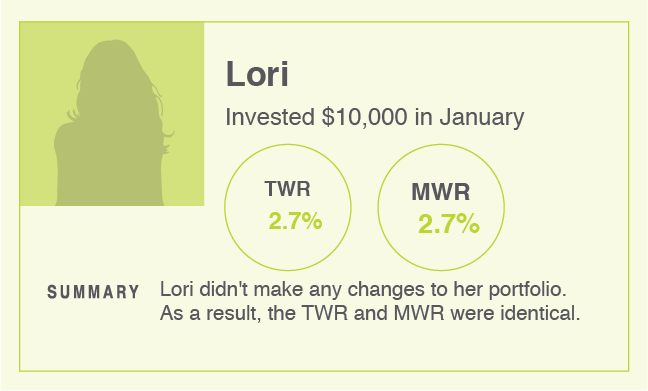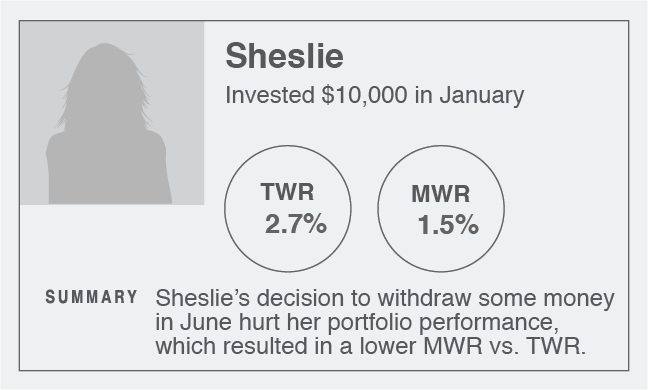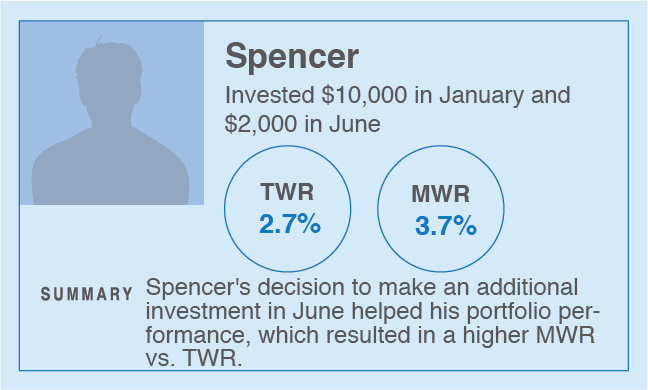Time-Weighted Returns vs Money-Weighted Returns
Time-weighted vs. Money Weighted Returns
As an investor it’s important to know and monitor the performance of your investments and investment account. Step one is understanding performance measurements and what they tell you.
There are two standard ways of measuring performance: time-weighted returns (TWR) and money-weighted returns (MWR). TWR provides investors with a good measure to compare the performance of a fund against other funds and against key benchmarks. MWR provides investors with a good measure of their personal account performance.
There are two standard ways of measuring performance: time-weighted returns (TWR) and money-weighted returns (MWR). TWR provides investors with a good measure to compare the performance of a fund against other funds and against key benchmarks. MWR provides investors with a good measure of their personal account performance.
What's the Difference?
Time-Weighted Returns (TWR)
Measures the rate of return on a fund over a period of time, excluding your investment decision-making and trading activity related to that fund (e.g., withdrawals, deposits, transfers)
Pros
- Can measure fund manager performance and compare it to fund benchmark
- Offers a rate that can be compared to other funds
Cons
- Impact of any changes you decided to make related to a fund during the period are not reflected in the rate
Best Use
- When comparing one fund or fund manager's performance to another
Money-Weighted Returns (MWR)
Measures the rate of return on an account over a period of time, including your investment decision-making and trading activity in the account (e.g., withdrawals, deposits, transfers)
Pros
- Shows your personal investment experience and account performance
- Helps clarify the impact your investment activity decisions are having on your account
Cons
- Not an effective measure of a portfolio manager's performance
- Can't be used to compare performance of other funds
Best Use
- When determining your account performance and the impact of your investment activity decisions
TWR and MWR in Action
To understand the difference between the two types of returns, consider the following hypothetical examples of three investors: Lori, Sheslie and Spencer. In each case, an initial investment is made on January 1, the markets declined by 4% between January 1 and June 30, and then rose by 7% between July 1 and December 31.
In the first scenario, Lori made no changes to her account over the year. In the second scenario, Sheslie was worried about the market decline and withdrew some of her investment on June 30. In the third scenario, Spencer saw the decline as an opportunity and made an additional investment on June 30.
In the first scenario, Lori made no changes to her account over the year. In the second scenario, Sheslie was worried about the market decline and withdrew some of her investment on June 30. In the third scenario, Spencer saw the decline as an opportunity and made an additional investment on June 30.
TWR or MWR: Merits for Both
TWR and MWR rates both offer value to investors. TWR is best for comparing one fund or fund manager's performance to another, while MWR is best for measuring the performance of your personal account.
By considering both measures, you can have a clear picture of individual fund performance, as well as your account performance and the impact of your investment decisions on your portfolio.
To learn more, speak with your financial advisor.
This should not be construed to be legal or tax advice. Please consult your own legal and tax advisor.
Starlight, Starlight Investments, Starlight Capital and all other related Starlight logos are trademarks of Starlight Group Property Holdings Inc.
By considering both measures, you can have a clear picture of individual fund performance, as well as your account performance and the impact of your investment decisions on your portfolio.
To learn more, speak with your financial advisor.
This should not be construed to be legal or tax advice. Please consult your own legal and tax advisor.
Starlight, Starlight Investments, Starlight Capital and all other related Starlight logos are trademarks of Starlight Group Property Holdings Inc.



